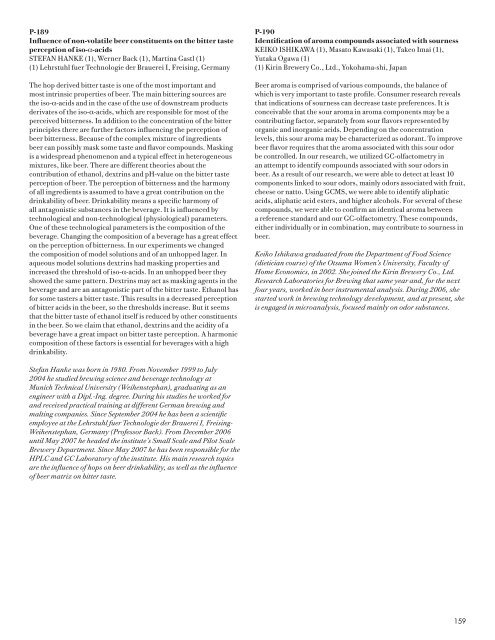Program Book - Master Brewers Association of the Americas
Program Book - Master Brewers Association of the Americas
Program Book - Master Brewers Association of the Americas
You also want an ePaper? Increase the reach of your titles
YUMPU automatically turns print PDFs into web optimized ePapers that Google loves.
P-189<br />
Influence <strong>of</strong> non-volatile beer constituents on <strong>the</strong> bitter taste<br />
perception <strong>of</strong> iso-α-acids<br />
STEFAN HANKE (1), Werner Back (1), Martina Gastl (1)<br />
(1) Lehrstuhl fuer Technologie der Brauerei I, Freising, Germany<br />
The hop derived bitter taste is one <strong>of</strong> <strong>the</strong> most important and<br />
most intrinsic properties <strong>of</strong> beer. The main bittering sources are<br />
<strong>the</strong> iso-α-acids and in <strong>the</strong> case <strong>of</strong> <strong>the</strong> use <strong>of</strong> downstream products<br />
derivates <strong>of</strong> <strong>the</strong> iso-α-acids, which are responsible for most <strong>of</strong> <strong>the</strong><br />
perceived bitterness. In addition to <strong>the</strong> concentration <strong>of</strong> <strong>the</strong> bitter<br />
principles <strong>the</strong>re are fur<strong>the</strong>r factors influencing <strong>the</strong> perception <strong>of</strong><br />
beer bitterness. Because <strong>of</strong> <strong>the</strong> complex mixture <strong>of</strong> ingredients<br />
beer can possibly mask some taste and flavor compounds. Masking<br />
is a widespread phenomenon and a typical effect in heterogeneous<br />
mixtures, like beer. There are different <strong>the</strong>ories about <strong>the</strong><br />
contribution <strong>of</strong> ethanol, dextrins and pH-value on <strong>the</strong> bitter taste<br />
perception <strong>of</strong> beer. The perception <strong>of</strong> bitterness and <strong>the</strong> harmony<br />
<strong>of</strong> all ingredients is assumed to have a great contribution on <strong>the</strong><br />
drinkability <strong>of</strong> beer. Drinkability means a specific harmony <strong>of</strong><br />
all antagonistic substances in <strong>the</strong> beverage. It is influenced by<br />
technological and non-technological (physiological) parameters.<br />
One <strong>of</strong> <strong>the</strong>se technological parameters is <strong>the</strong> composition <strong>of</strong> <strong>the</strong><br />
beverage. Changing <strong>the</strong> composition <strong>of</strong> a beverage has a great effect<br />
on <strong>the</strong> perception <strong>of</strong> bitterness. In our experiments we changed<br />
<strong>the</strong> composition <strong>of</strong> model solutions and <strong>of</strong> an unhopped lager. In<br />
aqueous model solutions dextrins had masking properties and<br />
increased <strong>the</strong> threshold <strong>of</strong> iso-α-acids. In an unhopped beer <strong>the</strong>y<br />
showed <strong>the</strong> same pattern. Dextrins may act as masking agents in <strong>the</strong><br />
beverage and are an antagonistic part <strong>of</strong> <strong>the</strong> bitter taste. Ethanol has<br />
for some tasters a bitter taste. This results in a decreased perception<br />
<strong>of</strong> bitter acids in <strong>the</strong> beer, so <strong>the</strong> thresholds increase. But it seems<br />
that <strong>the</strong> bitter taste <strong>of</strong> ethanol itself is reduced by o<strong>the</strong>r constituents<br />
in <strong>the</strong> beer. So we claim that ethanol, dextrins and <strong>the</strong> acidity <strong>of</strong> a<br />
beverage have a great impact on bitter taste perception. A harmonic<br />
composition <strong>of</strong> <strong>the</strong>se factors is essential for beverages with a high<br />
drinkability.<br />
Stefan Hanke was born in 1980. From November 1999 to July<br />
2004 he studied brewing science and beverage technology at<br />
Munich Technical University (Weihenstephan), graduating as an<br />
engineer with a Dipl.-Ing. degree. During his studies he worked for<br />
and received practical training at different German brewing and<br />
malting companies. Since September 2004 he has been a scientific<br />
employee at <strong>the</strong> Lehrstuhl fuer Technologie der Brauerei I, Freising-<br />
Weihenstephan, Germany (Pr<strong>of</strong>essor Back). From December 2006<br />
until May 2007 he headed <strong>the</strong> institute’s Small Scale and Pilot Scale<br />
Brewery Department. Since May 2007 he has been responsible for <strong>the</strong><br />
HPLC and GC Laboratory <strong>of</strong> <strong>the</strong> institute. His main research topics<br />
are <strong>the</strong> influence <strong>of</strong> hops on beer drinkability, as well as <strong>the</strong> influence<br />
<strong>of</strong> beer matrix on bitter taste.<br />
P-190<br />
Identification <strong>of</strong> aroma compounds associated with sourness<br />
KEIKO ISHIKAWA (1), Masato Kawasaki (1), Takeo Imai (1),<br />
Yutaka Ogawa (1)<br />
(1) Kirin Brewery Co., Ltd., Yokohama-shi, Japan<br />
Beer aroma is comprised <strong>of</strong> various compounds, <strong>the</strong> balance <strong>of</strong><br />
which is very important to taste pr<strong>of</strong>ile. Consumer research reveals<br />
that indications <strong>of</strong> sourness can decrease taste preferences. It is<br />
conceivable that <strong>the</strong> sour aroma in aroma components may be a<br />
contributing factor, separately from sour flavors represented by<br />
organic and inorganic acids. Depending on <strong>the</strong> concentration<br />
levels, this sour aroma may be characterized as odorant. To improve<br />
beer flavor requires that <strong>the</strong> aroma associated with this sour odor<br />
be controlled. In our research, we utilized GC-olfactometry in<br />
an attempt to identify compounds associated with sour odors in<br />
beer. As a result <strong>of</strong> our research, we were able to detect at least 10<br />
components linked to sour odors, mainly odors associated with fruit,<br />
cheese or natto. Using GCMS, we were able to identify aliphatic<br />
acids, aliphatic acid esters, and higher alcohols. For several <strong>of</strong> <strong>the</strong>se<br />
compounds, we were able to confirm an identical aroma between<br />
a reference standard and our GC-olfactometry. These compounds,<br />
ei<strong>the</strong>r individually or in combination, may contribute to sourness in<br />
beer.<br />
Keiko Ishikawa graduated from <strong>the</strong> Department <strong>of</strong> Food Science<br />
(dietician course) <strong>of</strong> <strong>the</strong> Otsuma Women’s University, Faculty <strong>of</strong><br />
Home Economics, in 2002. She joined <strong>the</strong> Kirin Brewery Co., Ltd.<br />
Research Laboratories for Brewing that same year and, for <strong>the</strong> next<br />
four years, worked in beer instrumental analysis. During 2006, she<br />
started work in brewing technology development, and at present, she<br />
is engaged in microanalysis, focused mainly on odor substances.<br />
159



